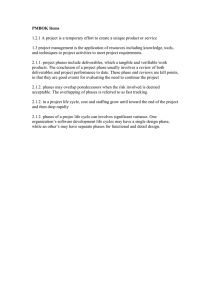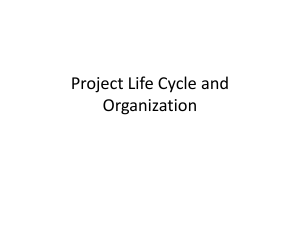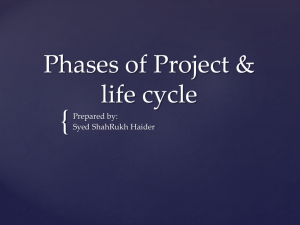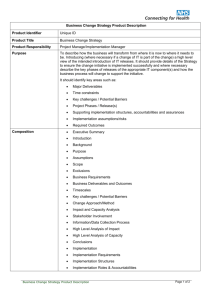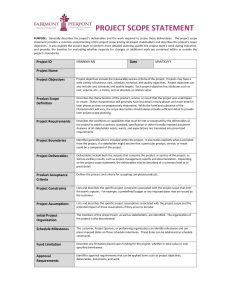1. Project Management Life cycle -A1
advertisement
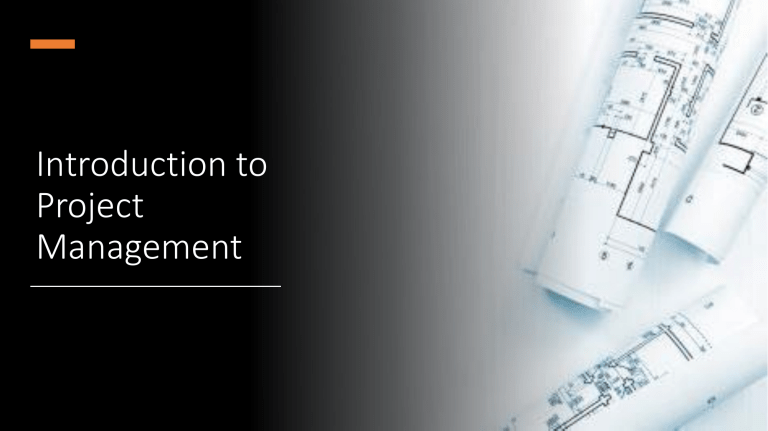
Introduction to Project Management What is a project? Project Definition • A project is a set of tasks which must be completed in order to arrive at a particular goal or outcome. Depending on the size and scope of the project, these tasks may be simple or elaborate, but all projects can be broken down into objectives and what needs to be done to achieve them. • Organizations and individuals manage projects with a wide range of objectives. These can take many forms, from constructing a building, to planning an event and even completing a certain duty. Retailers, for example, may pursue projects that improve the way they track order fulfillment. Construction teams complete projects any time they plan and build something—and so on! Key Terms 1. Project Lifecycle • The project lifecycle refers to the five phases all projects must progress through, from start to finish. The five phases of a project lifecycle serve as the most basic outline that give a project definition. These five phases are: initiation, planning, execution, monitoring and closure. 2. Project Scope • Project scope is a key aspect of the project planning stage. In many ways, it is the starting point. Determining project scope requires the project manager and their team to set goals and objectives, detail deliverables, create tasks, establish important dates and more. Project scope defines desired outcomes and all specific factors which will affect reaching them. 3. Stakeholder • A stakeholder refers to anyone and everyone involved in a project. A stakeholder can be involved at every stage of the project, or just in a certain way. Stakeholder analysis helps categorize how investors, team members, vendors, contractors and more can affect your project. Key Terms (2) 4. Deliverable • A deliverable refers to the specific outcome(s) a project creates. Deliverables can be “tangible” or “intangible,” meaning they can be a physical product or something conceptual. Typically, deliverables are the need that inspired the project in the first place. If someone contracts a builder to design and construct an office space, the office is a tangible deliverable. 5. Milestone • Milestones are predetermined achievements that help track project progress. Think of milestones as checkpoints. These checkpoints are decided on before a project begins, so the project manager and team know when they are on track to achieve deliverables. Without milestones, it’s difficult to know if the project is on the road to success or needs to reroute. 6. Resources • A resource is anything necessary to complete a project. In a construction project, materials are an essential resource. That said, other resources — like time, labor and equipment — are just as important. A project manager must be able to identify all of the project resources in order to create a resource plan and manage the resources accordingly. When resources are left unaccounted for, it is easy to mismanage them. Key Terms (3) 7. Dependencies • Project dependencies refer to how resources must be shared and allocated within a project. Many projects will use the same physical materials for different purposes and across different stages. Understanding this dependency is the only way to ensure there is enough of the resource to go around. Similarly, all projects are broken down into tasks. When one task cannot begin before another is completed, these tasks share a dependency. Project Management Lifecycle Initiation Phase This is the starting point of the project. The project gets conceptualized in this phase. In this stage, the following steps are implemented: • The project idea is either created or the client approaches the idea. The idea can be the solution to an existing problem or a new opportunity in business (e.g., new smartphone model launch) • A business case document is created providing the solution to implement the idea after the brainstorming sessions consisting of the team, client, and project managers. • Project managers and concerned teams check the feasibility of implementing the project in terms of profits, cost, timeline, resources, etc. • Once the project has passed this feasibility test, it is proposed for approval from the leadership team of the company/business unit. • During approval, SOW for the project is signed, and the budget is allocated. Planning Phase This is the second phase of project management. During this phase, a detailed project plan is created. This plan includes tasks, resources required, timelines, cost, etc. In addition, further planning for prioritizing requirements is done. Gantt chart, which indicates timelines for the various task, is one of the important documents created for planning. Different plans that are created depending on the type of project are: • Communication Plan: A good communication plan ensures the success of the project. It determines how the information is to be shared amongst the various groups involved (setting up the mail, Skype, creating a distribution list, etc.) The escalation matrix is part of this plan that is used to escalate teams for issues. • Resource Plan: It identifies resources required for project and consumption and schedule to procure the resources. The mapping of human resources is outlined in this plan. • Quality Plan: The plan consists of a detailed description of quality standards adopted, quality testing, and assurance used to maintain the standards. • Deployment Plan: It includes the outline of deploying the project deliverables. The approach towards deployment, the responsibility of team members during and after the deployment, issue tracking, and support on project post completion of the project. Execution Phase Done with the project idea finalization and planning. Now it’s time to set to work. In this phase, previous planning is put into action. This phase depends highly on planning. Better the plan better will be the execution. Project managers follow the below steps in this process: • Resource allocation and ensuring its timely delivery. • Assigning the tasks to team members on a daily basis • Taking daily meetings • Creating a status report based on daily meetings and the progress of the project. Here the entire team comes to the picture as it starts with actual work (e.g. development of software, manufacturing). Daily targets are set; the team has to ensure to meet them; in case of delay, they have to report to project managers. Monitoring and Controlling Phase This phase is merged with the execution phase because both occur at the same time. The main objective here is to ensure that execution is carried out as per the plan. Timelines and costs adhere. Below points are implemented during monitoring: • Set the key performance indicators (KPI’s). • Compare the progress plan or status report with the project plan to measure KPI’s. • For any deviation from the project, reduce the deviation and redefine KPI’s. • Update the plan for any changes to meet the deadline. • Monitor budget utilization. • Monitor the quality of the project. Closure Phase Now that project is completed, and it is time to deploy the project to the client or launch in the market. This is where the collaborated efforts come to a fruitful end!! A deployment plan created in the planning phase comes into action. The closure phase has: • Releasing the deliverables(product/service) to the stakeholders. • Communicating the closure to stakeholders and business partners. • Signing off business documents. • Releasing the team members and closing the contracts. • Payment and documentation filing. • Documenting lessons learned and best practices adopted during the project so that it can be used for future reference for other projects. • Setting up support and maintenance structure as per the requirement. So above are the project life cycle phases. Although initiating a new project may seem a gigantic task but by breaking it into phases ensures the achievable target. But these phases aren’t mutually exclusive; they may overlap in practice. The execution and control phases that we have seen above occur at the same time. Likewise, the same thing can happen in other phases too.
